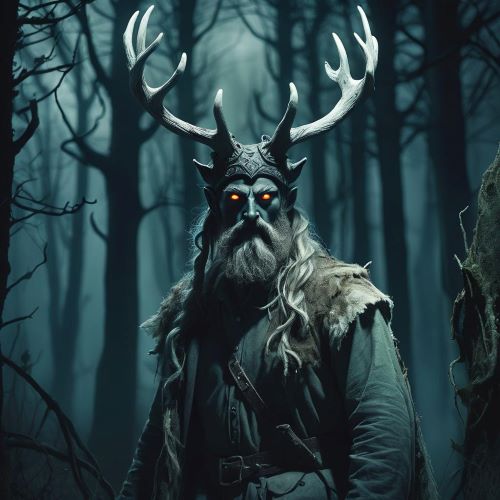Celtic Ghosts
Celtic Ghosts are haunting figures woven into the fabric of ancient Celtic mythology and folklore, embodying the mysterious connection between the living and the dead. These spectral entities range from sorrowful spirits of the departed to malevolent apparitions guarding sacred sites or seeking vengeance. Deeply tied to the Celtic belief in the Otherworld—a spiritual realm that exists parallel to our own—Celtic Ghosts were seen not just as remnants of the dead, but as active presences with messages, warnings, or unfinished business. Their appearances often marked moments of transition, prophecy, or spiritual significance.
In Celtic traditions, ghosts were rarely simple or one-dimensional. Many tales speak of ancestral spirits who returned to offer guidance or protection, especially during liminal times such as Samhain, when the veil between worlds was believed to be thinnest. During these festivals and seasonal changes, encounters with Celtic Ghosts were more common, and special rituals were performed to honor or appease them. These spirits could bring fortune or misfortune depending on how they were treated by the living. Respect for the dead and the invisible world was a core part of Celtic spiritual life, influencing everything from burial rites to storytelling.
Celtic Ghosts were often tied to specific locations—old forests, standing stones, burial mounds, and misty lakes—places that were thought to be gateways to the Otherworld. Some ghosts were guardians of these sacred spaces, appearing as shadowy figures or whispering voices. Others were bound to tragic events, endlessly re-enacting a moment of sorrow or betrayal. Stories of the bean sídhe (banshee), a spirit whose wail foretold death, or phantom warriors who roamed battlefields, illustrate how Celtic Ghosts were not only part of the supernatural landscape but also shaped communal memory and local lore.
The fear and reverence for these ghosts led to the creation of numerous protective charms, customs, and superstitions. In some regions, food and offerings were left at doorsteps to appease wandering spirits, while in others, fires were lit to guide friendly souls and ward off the dangerous ones. Celtic Ghosts could serve as omens, punishers, or comforters, depending on their origin and intent. These varied roles highlight the Celtic view of death not as an end, but as a transformation—a continuation of existence in a different form, capable of interacting with the living.
Today, interest in Celtic Ghosts has endured in literature, film, and folklore studies, drawing attention to the rich spiritual and psychological depth of these ancient beliefs. As part of a broader Celtic mythological tradition, these spirits continue to captivate modern audiences with their eerie presence and symbolic power. Whether seen as echoes of the past or guides from the Otherworld, Celtic Ghosts remain compelling figures that bridge history, myth, and the enduring mystery of life beyond death. Their legends persist, reminding us of the unseen forces that shape our world and the timeless stories that connect us to the ancestors.
Celtic Ghosts are haunting figures woven into the fabric of ancient Celtic mythology and folklore, embodying the mysterious connection between the living and the dead. These spectral entities range from sorrowful spirits of the departed to malevolent apparitions guarding sacred sites or seeking vengeance. Deeply tied to the Celtic belief in the Otherworld—a spiritual realm that exists parallel to our own—Celtic Ghosts were seen not just as remnants of the dead, but as active presences with messages, warnings, or unfinished business. Their appearances often marked moments of transition, prophecy, or spiritual significance.
In Celtic traditions, ghosts were rarely simple or one-dimensional. Many tales speak of ancestral spirits who returned to offer guidance or protection, especially during liminal times such as Samhain, when the veil between worlds was believed to be thinnest. During these festivals and seasonal changes, encounters with Celtic Ghosts were more common, and special rituals were performed to honor or appease them. These spirits could bring fortune or misfortune depending on how they were treated by the living. Respect for the dead and the invisible world was a core part of Celtic spiritual life, influencing everything from burial rites to storytelling.
Celtic Ghosts were often tied to specific locations—old forests, standing stones, burial mounds, and misty lakes—places that were thought to be gateways to the Otherworld. Some ghosts were guardians of these sacred spaces, appearing as shadowy figures or whispering voices. Others were bound to tragic events, endlessly re-enacting a moment of sorrow or betrayal. Stories of the bean sídhe (banshee), a spirit whose wail foretold death, or phantom warriors who roamed battlefields, illustrate how Celtic Ghosts were not only part of the supernatural landscape but also shaped communal memory and local lore.
The fear and reverence for these ghosts led to the creation of numerous protective charms, customs, and superstitions. In some regions, food and offerings were left at doorsteps to appease wandering spirits, while in others, fires were lit to guide friendly souls and ward off the dangerous ones. Celtic Ghosts could serve as omens, punishers, or comforters, depending on their origin and intent. These varied roles highlight the Celtic view of death not as an end, but as a transformation—a continuation of existence in a different form, capable of interacting with the living.
Today, interest in Celtic Ghosts has endured in literature, film, and folklore studies, drawing attention to the rich spiritual and psychological depth of these ancient beliefs. As part of a broader Celtic mythological tradition, these spirits continue to captivate modern audiences with their eerie presence and symbolic power. Whether seen as echoes of the past or guides from the Otherworld, Celtic Ghosts remain compelling figures that bridge history, myth, and the enduring mystery of life beyond death. Their legends persist, reminding us of the unseen forces that shape our world and the timeless stories that connect us to the ancestors.


